Janome Skyline S3 Instruction Manual
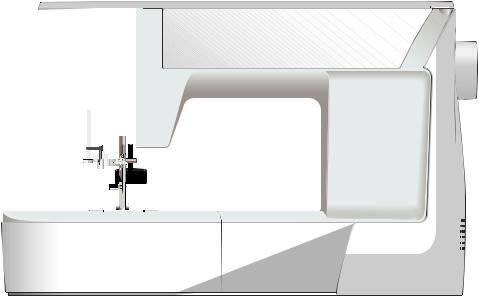
Instruction Book
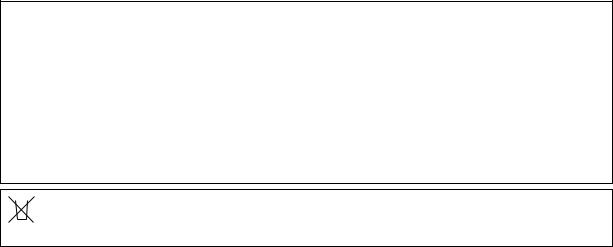
IMPORTANT SAFETY INSTRUCTIONS
When using an electrical appliance, basic safety precautions should always be followed, including the following:
This sewing machine is designed and manufactured for household use only. Read all instructions before using this sewing machine.
DANGER— To reduce the risk of electric shock:
1.An appliance should never be left unattended when plugged in. Always unplug this sewing machine from the electric outlet immediately after using and before cleaning.
WARNING—To reduce the risk of burns, fire, electric shock, or injury to persons:
1.Do not allow to be used as a toy. Close attention is necessary when this sewing machine is used by or near children.
2.Use this appliance only for its intended use as described in this owner’s manual.
Use only attachments recommended by the manufacturer as contained in this owner’s manual.
3.Never operate this sewing machine if it has a damaged cord or plug, if it is not working properly, if it has been dropped or damaged, or dropped into water.
Return this sewing machine to the nearest authorized dealer or service center for examination, repair, electrical or mechanical adjustment.
4.Never operate the appliance with any air opening blocked. Keep ventilation openings of this sewing machine and foot controller free from accumulation of lint, dust and loose cloth.
5.Never drop or insert any object into any opening.
6.Do not use outdoors.
7.Do not operate where aerosol (spray) products are being used or where oxygen is being administered.
8.To disconnect, turn all controls to the off (“O”) position, then remove plug from outlet.
9.Do not unplug by pulling on cord. To unplug, grasp the plug, not the cord.
10.Keep fingers away from all moving parts. Special care is required around the sewing machine needle and/or cutting blade.
11.Always use the proper needle plate. The wrong plate can cause the needle to break.
12.Do not use bent needles.
13.Do not pull or push fabric while stitching. It may deflect the needle causing it to break.
14.Switch this sewing machine off (“O”) when making any adjustment in the needle area, such as threading the needle, changing the needle, threading the bobbin or changing the presser foot, and the like.
15.Always unplug this sewing machine from the electrical outlet when removing covers, lubricating, or when making any other adjustments mentioned in this owner’s manual.
SAVE THESE INSTRUCTIONS
For Europe only:
This appliance can be used by children aged from 8 years and above and persons with reduced physical, sensory or mental capabilities or lack of experience and knowledge if they have been given supervision or instruction concerning use of the appliance in a safe way and understand the hazards involved. Children shall not play with the appliance. Cleaning and user maintenance shall not be made by children without supervision.
For outside Europe (except U.S.A and Canada):
This appliance is not intended for use by persons (including children) with reduced physical, sensory or mental capabilities, or lack of experience and knowledge, unless they have been given supervision or instruction concerning use of the appliance by a person responsible for their safety.
Children should be supervised to ensure that they do not play with the appliance.
 Please note that on disposal, this product must be safely recycled in accordance with relevant
Please note that on disposal, this product must be safely recycled in accordance with relevant 

 National legislation relating to electrical/electronic products. If in doubt please contact your
National legislation relating to electrical/electronic products. If in doubt please contact your  retailer for guidance. (European Union only)
retailer for guidance. (European Union only)
1
TABLE OF CONTENTS
ESSENTIAL PARTS |
|
Names of Parts............................................................... |
3 |
Standard Accessories..................................................... |
4 |
Accessory Storage.......................................................... |
5 |
Extension Table.............................................................. |
5 |
Free-arm sewing............................................................. |
5 |
GETTING READY TO SEW |
|
Connecting the Power Supply......................................... |
6 |
Operating Instructions:.................................................... |
6 |
Machine Operating Buttons............................................ |
7 |
Controlling Sewing Speed.............................................. |
8 |
Foot Control.................................................................... |
8 |
Function Keys................................................................. |
9 |
Raising and Lowering the Presser Foot........................ |
10 |
Adjusting the Foot Pressure.......................................... |
10 |
Dropping the Feed Dog................................................. |
10 |
Balancing Thread Tension............................................. |
11 |
Changing the Presser Foot........................................... |
12 |
Removing and Attaching the Foot Holder..................... |
12 |
Changing Needles........................................................ |
13 |
Fabric and Needle Chart............................................... |
13 |
Winding the Bobbin................................................... |
14-16 |
Threading the Machine................................................. |
17 |
Built-in Needle Threader............................................... |
18 |
Drawing up the Bobbin Thread..................................... |
19 |
Selecting the Patterns................................................... |
20 |
Customizing Machine Settings................................. |
21-23 |
BASIC SEWING |
|
Straight Stitch................................................................ |
24 |
Securing Seams............................................................ |
24 |
Sewing from the Edge of Thick Fabric.......................... |
24 |
Changing Sewing Direction........................................... |
24 |
Cutting Threads............................................................ |
25 |
Needle Plate Guides..................................................... |
25 |
Cornering Guide............................................................ |
25 |
Adjusting the Needle Drop Position.............................. |
26 |
Adjusting the Stitch Length........................................... |
26 |
Lock-a-Matic Stitch....................................................... |
27 |
Locking Stitch............................................................... |
27 |
Straight Stitch with Left Needle Position....................... |
27 |
Triple Stretch Stitch....................................................... |
28 |
Knit Stitch...................................................................... |
28 |
Zipper Sewing.......................................................... |
29-31 |
Gathering...................................................................... |
32 |
Pintucking..................................................................... |
32 |
Zigzag Stitch................................................................. |
33 |
Multiple Zigzag Stitch (Tricot stitch).............................. |
34 |
Overedge Stitch............................................................ |
34 |
Knit Stitch...................................................................... |
35 |
Double Overedge Stitch................................................ |
35 |
Visible hemming............................................................ |
36 |
Blind Hemming......................................................... |
36-37 |
Shell Tuck...................................................................... |
38 |
Button Sewing............................................................... |
38 |
Buttonholes................................................................... |
39 |
Square Buttonhole................................................... |
40-43 |
Round End and Fine Fabric Buttonholes...................... |
44 |
Keyhole Buttonhole....................................................... |
44 |
Stretch Buttonholes....................................................... |
44 |
Corded Buttonhole........................................................ |
45 |
Welted Buttonhole.................................................... |
46-47 |
Darning..................................................................... |
48-49 |
Tacking.......................................................................... |
50 |
Eyelet............................................................................ |
51 |
DECORATIVE STITCHING |
|
Applique........................................................................ |
52 |
Fringing......................................................................... |
53 |
Drawn Work.................................................................. |
53 |
Smocking...................................................................... |
54 |
Fagoting........................................................................ |
55 |
Scallop.......................................................................... |
55 |
French Knots................................................................. |
55 |
Patchwork Piecing........................................................ |
56 |
Patchwork..................................................................... |
56 |
Stippling........................................................................ |
57 |
Clasp Stitch................................................................... |
57 |
Satin Stitches................................................................ |
57 |
Twin Needle Sewing................................................ |
58-59 |
PROGRAMMING A PATTERN COMBINATION |
|
Pattern Combination..................................................... |
60 |
Programming Auto-lock Stitch...................................... |
61 |
Programming Automatic Thread Cutting....................... |
62 |
Pattern Combination with a Mirror Image..................... |
63 |
Resuming a Pattern from the Beginning........................ |
64 |
Resuming a Pattern Combination from the Beginning... 64 |
|
Bridge Stitches......................................................... |
65-66 |
Monogramming........................................................ |
67-68 |
Editing a Pattern Combination...................................... |
68 |
Deleting and Inserting a Pattern................................... |
69 |
Duplicating a Pattern..................................................... |
69 |
Uniform Stitch Adjustment............................................ |
70 |
Unified Needle Drop Position........................................ |
70 |
Individual Stitch Adjustment.......................................... |
71 |
Correcting Distorted Stitch Patterns............................. |
72 |
CARE AND MAINTENANCE |
|
Cleaning the Hook Area................................................ |
73 |
Cleaning the Inside of the Thread Guide...................... |
74 |
Problems and Warning Signals..................................... |
75 |
Troubleshooting............................................................ |
76 |
2
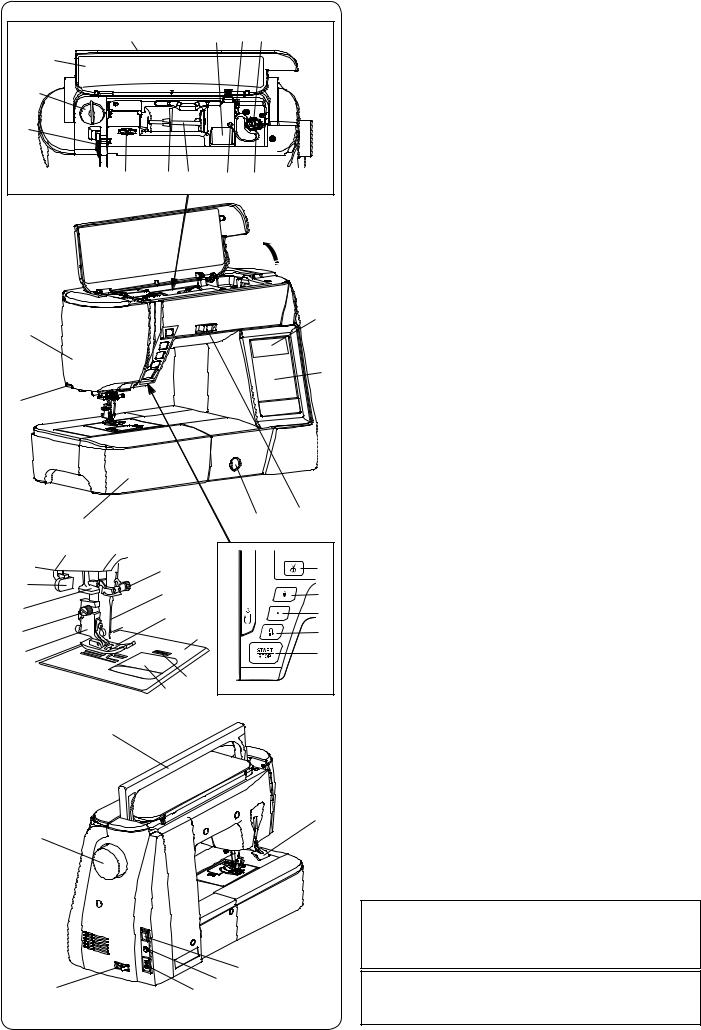
|
|
|
ESSENTIAL PARTS |
|
r |
t y u |
|
Names of Parts |
|
|
q Thread take-up lever |
|||
e |
|
|
||
|
|
w Foot pressure dial |
||
w |
|
|
e Reference chart |
|
|
|
r Top cover |
||
|
|
|
t Foot storage compartment |
|
q |
|
|
y Bobbin thread cutter B |
|
|
|
|
u Bobbin winder spindle |
|
|
|
|
i Bobbin thread cutter A |
|
!2 |
!1!0 o i |
|
o Hole for extra spool pin |
|
|
Spool pin |
|||
|
|
|
||
|
|
|
!0 |
|
|
|
|
Spool holder (large) |
|
|
|
|
!1 |
|
|
|
|
Thread tension dial |
|
|
|
|
!2 |
|
|
|
|
Face cover |
|
|
|
|
!3 |
|
|
|
|
Thread cutter |
|
|
|
|
!4 |
|
|
|
|
Extension table (accessory storage) |
|
|
|
|
!5 |
|
|
|
|
Start/stop button |
|
|
|
|
!6 |
|
|
|
|
Reverse button |
|
|
|
|
!7 |
|
|
|
@4 |
!8 |
|
!3 |
|
|
Auto-lock button |
|
|
|
Needle up/down button |
||
|
|
|
!9 |
|
|
|
|
Thread cutter button |
|
|
|
|
@0 |
|
|
|
|
Feed balancing dial |
|
|
|
@3 |
@1 |
|
|
|
@2 |
||
!4 |
|
|
Speed control slider |
|
|
|
Touch panel (Function keys) |
||
|
|
|
@3 |
|
|
|
|
LCD screen |
|
|
|
|
@4 |
|
|
|
|
Needle clamp screw |
|
|
|
|
@5 |
|
|
|
|
Needle |
|
|
|
|
@6 |
|
|
|
|
Zigzag foot A |
|
|
|
|
@7 |
|
|
|
|
Needle plate |
|
|
|
|
@8 |
|
|
|
|
Hook cover release button |
|
|
|
|
@9 |
|
|
|
|
Hook cover plate |
|
|
@1 |
@2 |
#0 |
|
!5 |
Foot holder |
|||
|
|
|||
|
|
|
#1 |
|
|
|
|
Setscrew |
|
|
|
|
#2 |
|
|
|
|
Needle threader |
|
|
@5 |
@0 |
#3 |
|
|
#4 |
|||
#4 |
|
|
Buttonhole lever |
|
@6 |
|
#5 |
||
|
!9 |
Carrying handle |
||
|
|
#6 |
||
#3 |
@7 |
!8 |
Handwheel |
|
#7 |
||||
#2 |
@8 |
!7 |
Drop feed lever |
|
Machine socket |
||||
#1 |
|
|
#8 |
|
|
!6 |
Foot control jack |
||
|
|
#9 |
||
|
|
|
Power switch |
|
|
@9 |
|
$0 |
|
|
|
$1 |
||
|
#0 |
|
Presser foot lifter |
|
#5 |
|
|
|
$1
#6
#7 |
#8#9$0 |
NOTE:
To carry the sewing machine, hold the carrying handle with your hand, and support the sewing machine with the other hand.
NOTE:
Sewing machine design and specifications are subject to change without prior notice.
3
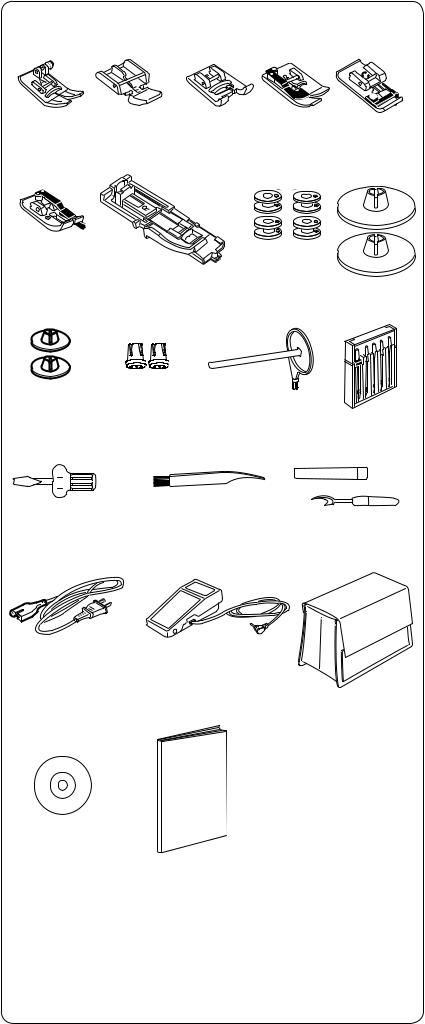
q |
w |
e |
r |
t |
y |
u |
i |
o |
!0 |
!1 |
!2 |
!3 |
!4 |
!5 |
!6 |
!7 |
!8 |
!9 |
@0 @1
Standard Accessories
q Zigzag foot A (set on the machine) w Zipper foot E
e Satin stitch foot F
r Blind hemming foot G t Overedge foot C
y 1/4˝ seam foot O
uAutomatic buttonhole foot R (in the accessory storage)
i Bobbin (4 pcs.) (1 set on the machine)
o Spool holder (large, 1 set on the machine) !0Spool holder (small)
!1Spool holder (special) !2Extra spool pin !3Needle set !4Screwdriver
!5Lint brush
!6Seam ripper (Buttonhole opener) !7Power cable
!8Foot control !9Semi-hard fabric cover @0Instructional video DVD @1Instruction book
4
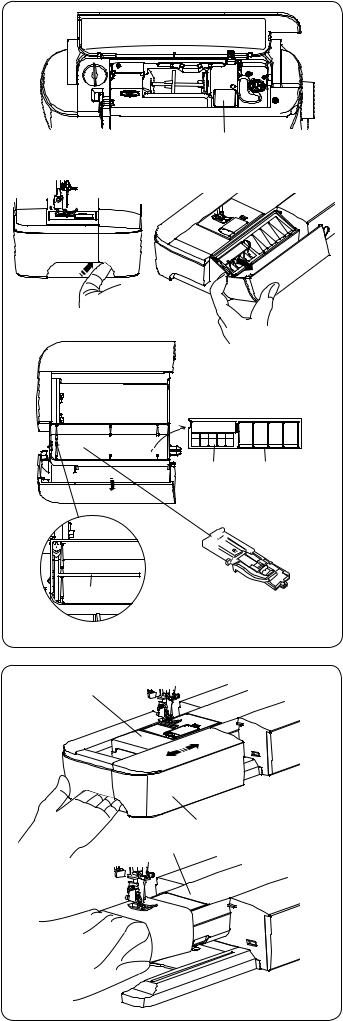
q
e q
 w
w
r
w
q
w
Accessory Storage
The accessories can be conveniently stored in the compartment of the extension table and the compartment under the top cover.
To store the accessories in the compartment of the extension table, push up the cover towards you to open the accessory storage.
q Presser foot
w Automatic buttonhole foot R
e Bobbin
r Extra spool pin
Other accessories can be also stored in the compartment in the extension table.
Extension Table
The extension table provides an extended sewing area and can be removed for free-arm sewing.
q Extension table w Free-arm
To detach:
Draw the table out to the left.
To attach:
Slide the table on the base and push the table to the right.
Free-arm sewing
Free-arm sewing is used for stitching sleeves, waistbands, pant legs or any other tubular garments. It is also useful for darning socks or mending knees or elbows.
w Free-arm
5
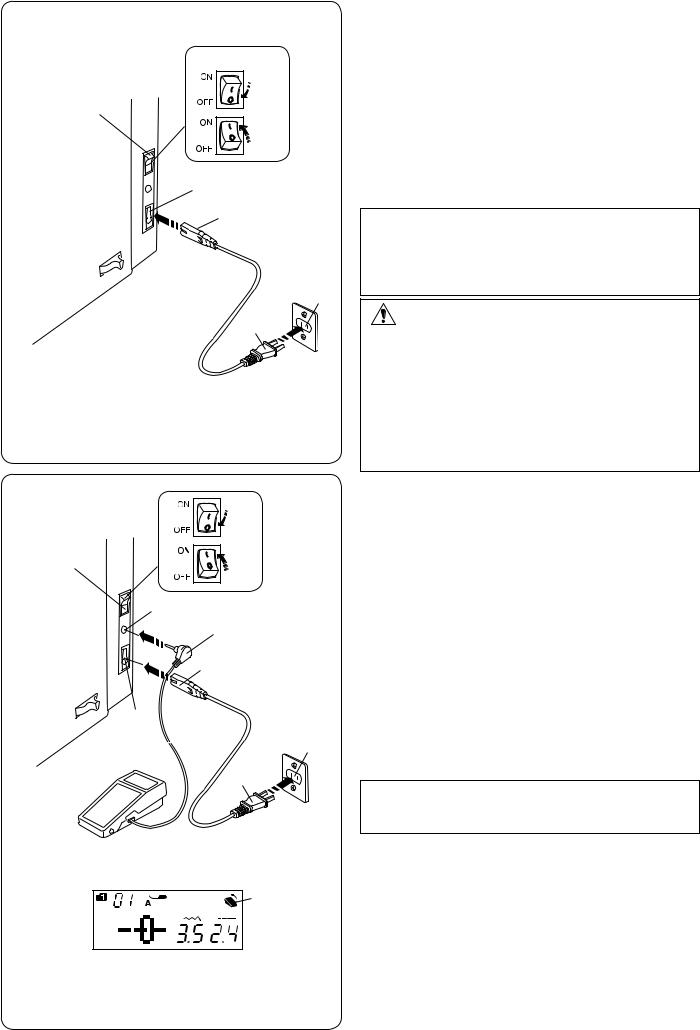
GETTING READY TO SEW
Connecting the Power Supply
|
|
z First make sure the power switch q is off. |
|
z |
x Insert the machine plug w of the power supply cord |
|
into the machine socket e. |
|
|
|
|
q |
|
c Insert the power supply plug r into the wall outlet t, |
c |
and turn the power switch q on. |
|
|
qPower switch |
|
|
|
|
|
|
wMachine plug |
|
|
eMachine socket |
e |
|
rPower supply plug |
|
tWall outlet |
|
|
|
|
w |
|
NOTE: |
|
|
Make sure to use the power supply cable that came |
|
|
with the machine. |
|
|
If you turn off the power switch, wait for 5 seconds |
|
|
before turning it on again. |
|
|
t |
r |
|
WARNING: |
|
While in operation, always keep your eyes on the |
|
|
|
sewing area, and do not touch any moving parts such |
|
|
as the thread take-up lever, handwheel or needle. |
|
|
Always turn off the power switch and unplug the |
|
|
machine from the power supply: |
-when leaving the machine unattended.
-when attaching or removing parts.
-when cleaning the machine.
|
|
|
|
|
Do not place anything on the foot control. |
|
|
|
|
|
If you wish to use the foot control, insert the pin connector |
|
|
|
z |
|
into the jack on the machine. |
|
|
|
|
z First make sure the power switch q is off. |
|
|
|
|
|
|
|
|
|
|
|
|
x Insert the pin connector w into the jack e on the |
|
|
|
v |
|
machine. |
q |
|
|
|
c Insert the machine plug r of the power supply cord |
|
|
|
|
|
||
|
|
|
|
|
into the machine socket t. |
|
|
|
|
|
v Insert the power supply plug y into the wall outlet u, |
e |
|
|
|
|
and turn the power switch on. |
|
|
w |
|
|
The foot control sign i will be displayed when the foot |
|
|
|
|
control is connected to the machine. |
|
|
|
|
|
|
|
|
r |
|
|
|
qPower switch |
|
|
|
|
wPin connector |
|
|
|
|
|
|
|
|
|
|
|
|
eJack |
t |
|
|
|
|
rMachine plug |
|
|
|
|
tMachine socket |
|
|
|
|
|
|
|
|
|
|
|
u |
yPower supply plug |
|
|
|
|
uWall outlet |
|
|
|
|
|
|
|
|
|
|
y |
|
iFoot control sign |
|
|
|
|
NOTE: |
|
|
|
|
|
|
|
|
|
|
|
|
The start/stop button does not work when the foot |
|
|
|
|
|
control is connected. |
Operating Instructions:
The symbol “O” on a switch indicates the “off” position of
i
the switch.
For the U.S.A. and Canada only
Polarized plug (one blade wider than the other):
To reduce the risk of electric shock, this plug is intended to fit in a polarized outlet only one way. If it does not fit fully in the outlet, reverse the plug. If it still does not fit, contact a qualified electrician to install the proper outlet. Do not modify the plug in any way.
6
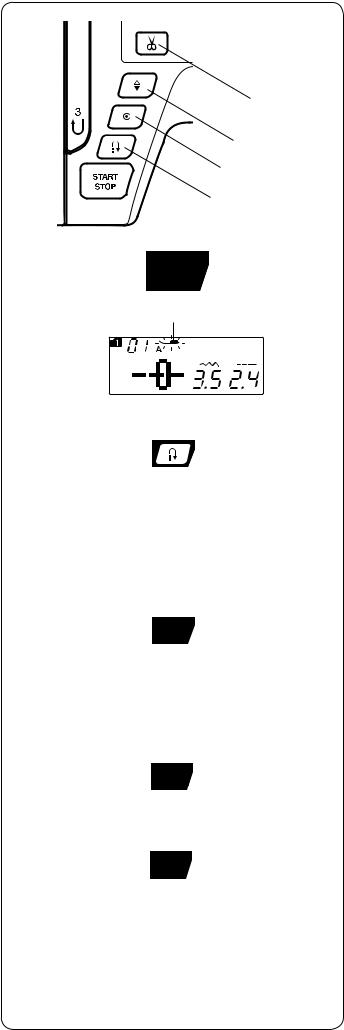
|
|
|
|
|
|
|
|
|
Machine Operating Buttons |
|||
|
|
|
|
|
|
|
|
|
q Start/stop button |
|||
|
|
|
|
|
|
|
|
|
Press this button to start or stop the machine. |
|||
|
|
|
|
|
|
|
|
|
The machine starts running slowly for the first few |
|||
|
|
|
|
|
|
|
|
|
stitches, it then runs at the speed set by the speed control |
|||
|
|
|
|
|
|
|
|
t |
slider. The machine runs slowly as long as this button is |
|||
|
|
|
|
|
|
|
|
pressed. |
||||
|
|
|
|
|
|
|
|
|
Pressing and holding this button while sewing will slow |
|||
|
|
|
|
|
|
|
|
r |
down the sewing speed and the machine will stop when |
|||
|
|
|
|
|
|
|
|
e |
the button |
is released. |
||
q |
|
|
|
|
|
|
|
NOTE: |
|
|
|
|
|
|
|
|
|
||||||||
|
|
|
|
|
|
|
|
|
|
|||
|
|
|
|
|
|
|
|
w |
• The start/stop button cannot be used when the foot |
|
||
|
|
|
|
|
|
|
|
control |
is connected to the machine. |
|
||
|
|
|
|
|
|
|
||||||
|
|
|
|
|
|
|
|
|
|
|||
|
|
|
|
|
|
|
|
|
• The machine will not run and the presser foot mark |
|
||
|
|
|
|
|
|
|
|
|
y will blink if you start the presser foot in the up |
|
||
|
|
|
|
|
q |
|
|
position. Lower the presser foot and press the start/ |
|
|||
|
|
|
|
|
|
|
stop button. |
|
||||
|
|
|
|
|
|
|
||||||
|
|
|
|
|
|
|
|
|
• You can select the desired start-up speed from |
|
||
|
|
|
|
|
|
|
y |
slow, medium or high (refer to page 22). |
|
|||
|
|
|
|
|
|
|
|
|
|
|
||
|
|
|
|
|
|
|
|
|
|
|
||
|
|
|
|
w Reverse button |
|||
|
|
|
|
When |
sewing stitch pattern 01, 04, 05, 10-12 (mode 1) or |
||
|
w |
55-56 |
|
(mode 2), the machine will sew in reverse as long |
|||
|
|
|
|
as the |
reverse button is pressed. |
||
|
|
|
|
If stitch |
pattern 01, 04, 05, 10-12 (mode 1) or 55-56 |
||
|
|
|
|
(mode 2) has been selected and the foot control is not |
|||
|
|
|
|
connected, the machine will start sewing in reverse as |
|||
|
|
|
|
long as the reverse button is pressed. |
|||
|
|
|
|
If you press the reverse button when sewing any other |
|||
|
|
|
|
patterns, the machine will immediately sew locking |
|||
|
|
|
|
stitches |
and automatically stop. |
||
|
|
|
|
e Auto-lock button |
|||
|
e |
|
|
When sewing stitch pattern 01, 04, 05, 10-12 (mode 1) |
|||
|
|
|
|
or 55-56 (mode 2), the machine will immediately sew |
|||
|
|
|
|
locking stitches and automatically stop when the auto- |
|||
|
|
|
|
lock button is pressed. |
|||
|
|
|
|
When sewing all other patterns, the machine will sew to |
|||
|
|
|
|
the end of the current pattern, sew locking stitches and |
|||
|
|
|
|
stop automatically. |
|||
|
|
|
|
The machine will trim the threads automatically after |
|||
|
|
|
|
locking the stitch when the auto thread cutting is turned |
|||
|
r |
on |
(refer to page 62). |
||||
|
|
Needle up/down button |
|||||
|
|
|
|
r |
|||
|
|
|
|
Press this button to bring the needle bar up or down. |
|||
|
|
|
|
The machine will stop with the needle in down position. |
|||
|
|
|
|
However, you can change the needle stop position in the |
|||
|
t |
machine setting mode (refer to page 22). |
|||||
|
|
|
|
t Thread cutter button |
|||
|
|
|
|
After finish sewing, press this button to trim the threads. |
|||
|
|
|
|
The needle bar automatically rises after trimming the |
|||
|
|
|
|
threads (refer to page 25). |
|||
|
|
|
|
|
|
|
|
|
|
|
|
NOTE: |
|||
|
|
|
|
Use the thread cutter on the face cover if the thread is |
|||
|
|
|
|
#30 or thicker (refer to page 25). |
|||
|
|
|
|
|
|
|
|
7
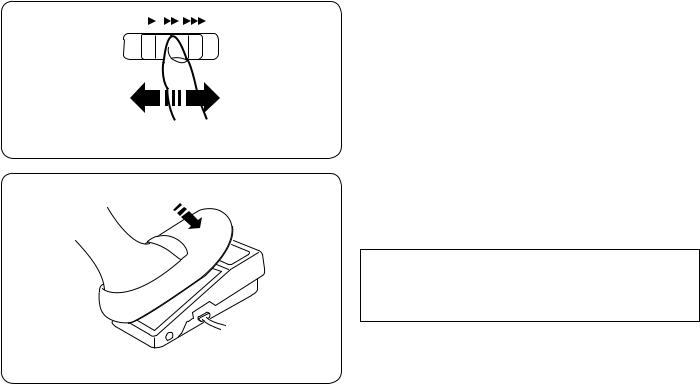
Controlling Sewing Speed
Speed control slider
You can limit the maximum sewing speed with the speed control slider according to your sewing needs.
To increase the sewing speed, move the slider to the right.
To decrease the sewing speed, move the slider to the left.
Foot Control
Pressing on the foot control can vary sewing speed. The harder you press the foot control, the faster the machine runs.
NOTE:
The machine runs at the maximum speed set by the speed control slider when the foot control is fully depressed.
Operating Instructions:
Foot control model YC-485EC is for use with this sewing machine.
8
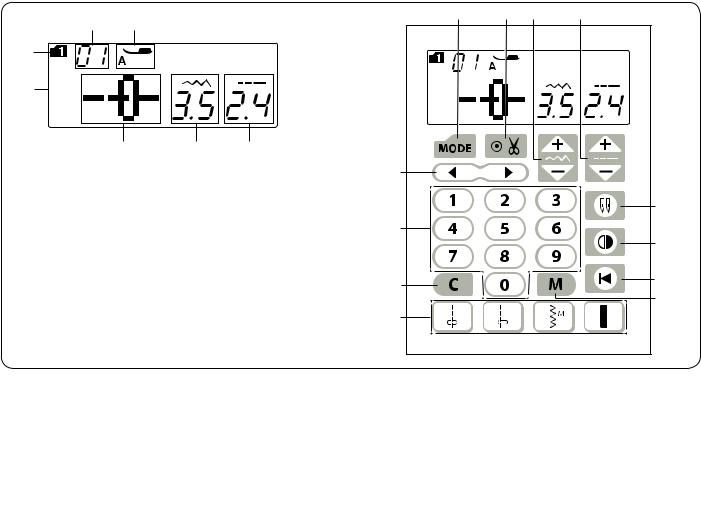
r |
t |
|
i |
o |
!0 |
!1 |
|
|
|
|
|
||
e |
|
|
|
|
|
|
q |
|
|
|
|
|
|
|
w |
y |
u |
|
|
|
|
|
|
!2 |
|
|
|
|
|
|
|
|
|
!6 |
|
|
|
!3 |
|
|
|
|
|
|
|
|
|
!7 |
|
|
|
!4 |
|
|
!8 |
|
|
|
|
|
!9 |
|
|
|
|
|
|
|
|
|
|
|
!5 |
|
|
|
Function Keys
q LCD screen
The LCD screen shows the following information when the machine is turned on:
w Stitch pattern e Mode
r Stitch pattern number
t Recommended type of presser foot y Stitch width
uStitch length
i Mode key (refer to pages 20, 21) Press the mode key to select the mode.
When the power is turned on, the pattern selection mode 1 is set automatically.
o Auto thread cutting key (refer to page 62)
Press this key if you wish to cut the threads automatically after finish sewing with a locking stitch.
When programming a pattern combination, press this key to cut the threads automatically after finish sewing.
!0Stitch width adjusting key (refer to pages 26, 33, 43) Press this key to alter the stitch width.
!1Stitch length adjusting key (refer to pages 26, 33, 43) Press this key to alter the stitch length.
!2Cursor key (refer to page 68)
Press “  ” or “
” or “  ” to move the cursor to check or edit the pattern combination.
” to move the cursor to check or edit the pattern combination.
!3Number keys (refer to page 20)
Enter a 2-digit pattern number to select the desired stitch pattern in modes 1 to 5.
!4Clear key (refer to pages 22, 69)
Press the clear key to clear the memorized stitch pattern. Press and hold this key until the buzzer sounds to delete the whole pattern combination.
!5Direct pattern selection keys (refer to page 20)
You can select the stitch patterns 01 , 04
, 04 , 10
, 10 and 24
and 24 in mode 1 directly.
in mode 1 directly.
!6Twin needle key (refer to page 58)
Press this key when sewing with a twin needle.
!7Mirror image key (refer to page 63)
Press this key to sew a mirror image of the selected pattern.
!8Startover key (refer to page 64)
Press this key to sew a pattern combination from the beginning.
!9Memory key (refer to page 60)
Press this key to register programmed pattern combinations.
Up to 50 stitch patterns combination can be memorized.
9

Raising and Lowering the Presser Foot
The presser foot lifter raises and lowers the presser foot.
|
w |
q Presser foot lifter |
|
You can raise the presser foot higher than the normal up |
|
|
|
|
q |
|
position. This helps you to place thick layers of fabrics |
|
under the foot. |
|
|
|
|
|
|
w Extra lifted position |
|
|
NOTE: |
|
|
Do not turn the handwheel or press the up/down |
|
|
needle button when the presser foot is in the extra |
|
|
lifted position. |
|
Adjusting the Foot Pressure |
|
q |
The foot pressure can be adjusted with the foot pressure |
|
|
dial located under the top cover. |
|
|
The dial has 7 setting positions from 1 to 7. |
|
|
For ordinary sewing, set 5 at the setting mark. |
|
|
q Foot pressure dial |
|
|
w Setting mark |
|
w |
Reduce the pressure when sewing fine synthetics and |
|
stretch fabrics. |
||
|
||
|
To reduce the pressure, set the dial at a lower number. |
|
|
Increase the pressure when sewing heavy weight fabrics. |
|
|
To increase the pressure, set the dial at a higher number. |
|
Dropping the Feed Dog |
|
The feed dog can be lowered for sewing on buttons, free |
|
motion quilting etc. |
|
Shift the drop feed lever toward you to lower the feed |
|
dog. |
|
q Drop feed lever |
|
w Feed dog |
|
Shift the drop feed lever away from you to raise the feed |
w |
dog, it will return to the up position when you start the |
|
machine. |
q
10

Balancing Thread Tension
Auto-thread tension
For general sewing, set the thread tension dial at AUTO, which covers a wide range of sewing conditions.
q Thread tension dial
q
Balanced thread tension
w q For straight stitch sewing, both needle and bobbin threads will join at the middle of the fabrics.
e
r |
|
For zigzag stitch sewing, the needle thread will appear |
|
|
|
slightly on the wrong side of the fabric. |
|
w |
q |
q Wrong side of fabric |
|
w Right side of fabric |
|||
|
|
||
e |
|
e Needle thread |
|
|
r Bobbin thread |
||
|
|
r
|
|
Manual thread tension adjustment |
|
|
You may need to adjust tension manually depending |
|
|
on the sewing conditions such as the type of fabric and |
|
|
number of layers. |
|
|
If the needle thread is too tight, the bobbin thread |
w |
|
appears on the right side of the fabric. |
q |
q Wrong side of fabric |
|
e |
|
w Right side of fabric |
|
e Needle thread |
|
|
|
|
|
|
r Bobbin thread |
|
|
Turn the thread tension dial to a lower number to |
r |
|
decrease the thread tension. |
|
|
|
|
|
If the needle thread is too loose, the needle thread loops |
w |
q |
on the underside of the fabric. |
|
q Wrong side of fabric |
|
|
|
|
e |
|
w Right side of fabric |
|
|
e Needle thread |
|
|
r Bobbin thread |
r |
|
Turn the thread tension dial to a higher number to |
|
increase the thread tension. |
|
|
|
11
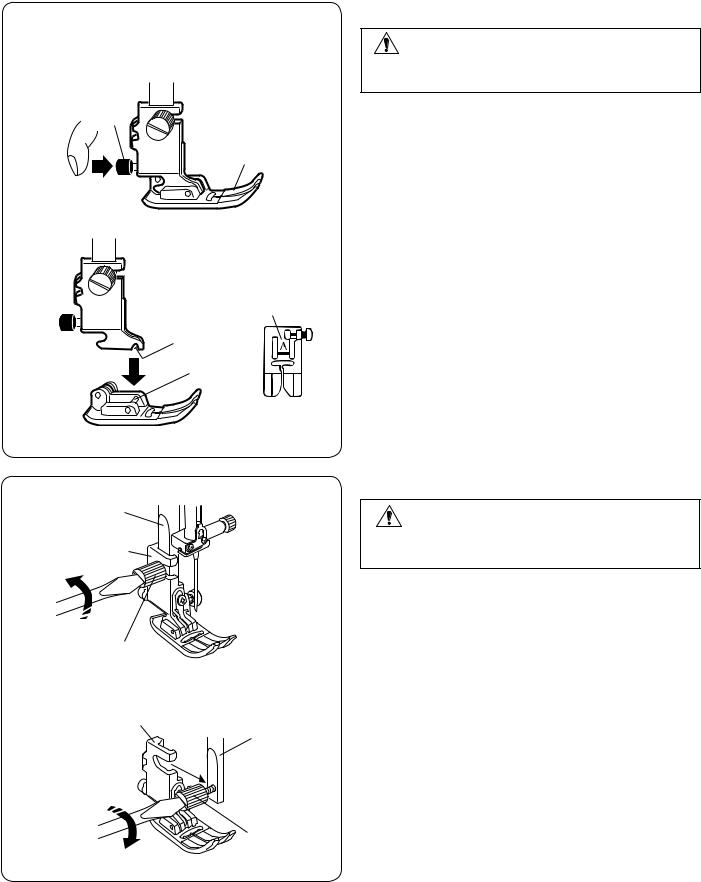
Changing the Presser Foot
|
CAUTION: |
|
|
Always make sure to turn the power switch OFF |
|
|
before replacing the presser foot. |
|
q |
Raise the needle to its highest position and raise the |
|
presser foot lifter. |
||
|
||
|
Press the red button on the back of the foot holder. |
|
w |
The presser foot will drop off. |
|
|
q Red button |
|
|
w Presser foot |
Attaching the presser foot
Place the presser foot so that the pin on the foot lies just
tunder the groove of the foot holder.
e |
|
Lower the presser bar to lock the foot in place. |
|
Each foot is marked with an identification letter. |
|
|
r |
e Groove |
|
r Pin |
|
|
|
|
|
|
t Identification letter |
|
Removing and Attaching the Foot Holder |
q |
CAUTION: |
|
|
w |
Always make sure to turn the power switch OFF |
before replacing the presser foot. |
|
|
Removing the foot holder |
|
Raise the needle to its highest position and raise the |
|
presser foot lifter. |
|
Loosen the setscrew. |
e |
Remove the foot holder. |
|
q Presser bar |
|
w Foot holder |
|
e Setscrew |
w |
|
q |
Attaching the foot holder |
|
Attach the foot holder to the presser bar from the rear. |
|
Tighten the thumbscrew securely with the screwdriver. |
e |
|
12
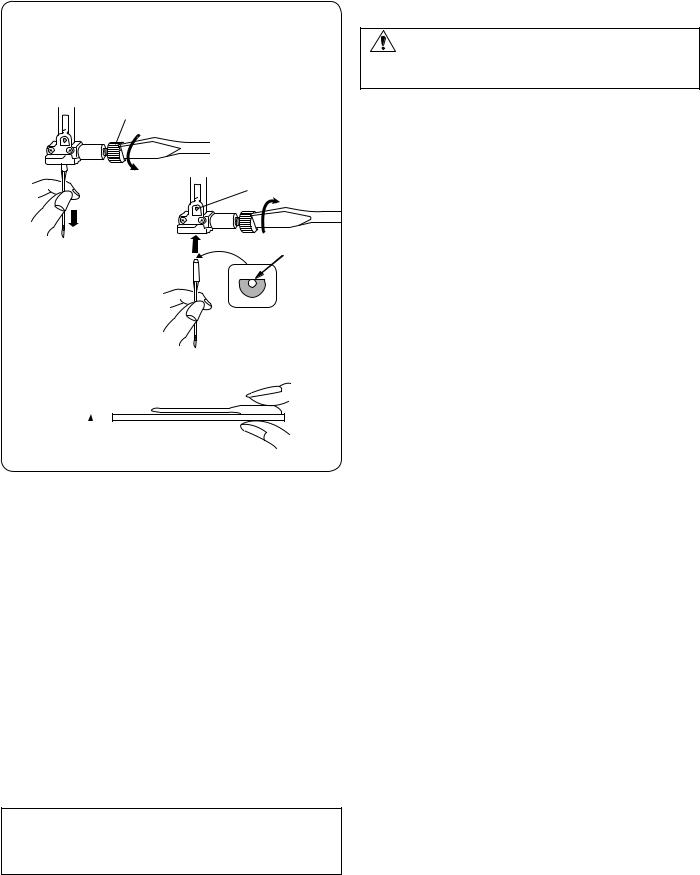
q
e
w
r
Fabric |
Thread |
Needle |
||
|
Lawn |
|
|
|
|
Georgette |
Silk #80-100 |
#9/65-11/75 |
|
Fine |
Tricot |
Cotton #80-100 |
||
Blue tip needle |
||||
|
Organza |
Synthetic #80-100 |
||
|
Crepe |
|
|
|
|
Sheeting |
Silk #50 |
|
|
|
Jersey |
|
||
Medium |
Cotton #50-80 |
#11/75-14/90 |
||
|
Broadcloth |
Synthetic #50-80 |
|
|
|
Fleece |
|
|
|
|
Denim |
Silk #30-50 |
|
|
Heavy |
Tweed |
|
||
Cotton #40-50 |
#14/90-16/100 |
|||
weight |
Coating |
|||
Synthetic #40-50 |
|
|||
|
Quilting |
|
||
|
|
|
||
NOTE:
1 x twin needle, 1 x blue tip needles (#11/75), 2 x #11/75 needles and 1 x #14/90 needle are
included in the needle case (Part No. 820827007).
Changing Needles
CAUTION:
Always make sure to turn the power switch OFF before changing the needle.
Raise the needle by pressing the needle up/down button and lower the presser foot.
Turn the power switch off.
Loosen the needle clamp screw and remove the needle from the clamp.
q Needle clamp screw
Insert a new needle into the needle clamp with the flat side of the needle to the rear.
When inserting the needle into the needle clamp, push it up against the stopper pin and tighten the needle clamp screw firmly with a screwdriver.
w Flat side e Stopper pin
To check needle straightness, place the flat side of the needle onto something flat (a needle plate, glass etc.) The gap between the needle and the flat surface should be consistent.
Never use a blunt needle. r Gap
Fabric and Needle Chart
•For general sewing, use needle size 11/75 or 14/90.
•A fine thread and needle should be used for sewing lightweight fabrics, so the fabric will not be marred.
•Heavy fabrics require a needle large enough to pierce the fabric without fraying the needle thread.
•Always test the needle size on a small scrap of the fabric that will be used for actual sewing.
•In general, use the same thread for the needle and bobbin.
•When sewing stretch fabrics, very fine fabrics and synthetics, use a blue tip needle. The blue tip needle effectively prevents skipped stitches.
13
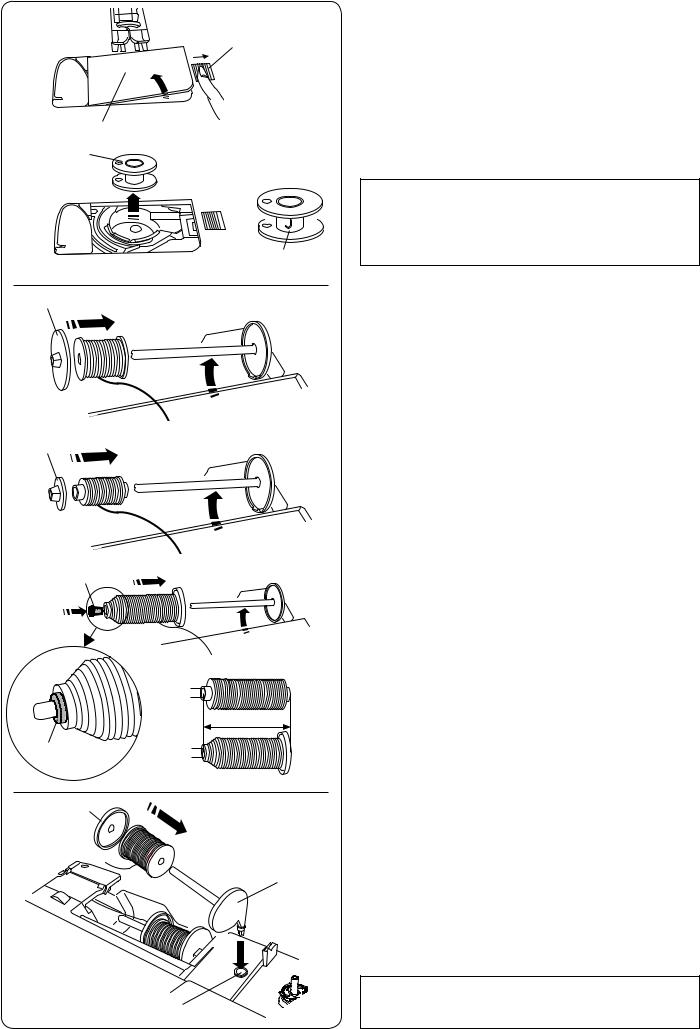
|
Winding the Bobbin |
|
|
Removing the Bobbin |
|
q |
Slide the hook cover release button to the right, and |
|
|
remove the hook cover plate. |
|
|
q Hook cover release button |
|
|
w Hook cover plate |
|
w |
Lift out the bobbin from the bobbin holder. |
|
e Bobbin |
||
|
||
e |
|
|
|
NOTE: |
|
|
Use the “J” plastic bobbins for horizontal hook (marked |
|
|
with “J” r). Using other bobbins, such as pre-wound |
|
|
paper bobbins, may cause stitching problems and/ or |
|
r |
damage to the bobbin holder. |
|
q |
Setting the spool of thread |
|
|
Lift up the spool pin. Place the spool of thread on the |
|
|
spool pin. |
|
|
Attach the large spool holder, and press it firmly against |
|
|
the spool of thread. |
|
|
q Large spool holder |
w |
Use the small spool holder to hold narrow or small spools |
|
of thread. |
|
w Small spool holder |
e |
Use the spool holder (special) to hold the specific size of |
|
|
|
the spool of threads as shown. |
|
The sizes of the spools of thread are as follows; |
|
The hole diameter of the spool has a range of 3/8˝ to |
|
7/16˝ (9.5 to 10.5 mm)), and the spool length has a range |
|
of 2 3/4˝ to 3˝ (70 to 75 mm). |
r |
e Spool holder (special) |
|
r Hole diameter (3/8˝ to 7/16˝) |
tt Spool length (2 3/4˝ to 3˝)
e |
r |
Firmly insert the spool holder (special) into the hole and |
|
hold the spool as illustrated. |
|||
|
|||
|
e |
Extra spool pin |
|
|
|
Use the extra spool pin when you need to wind a bobbin |
|
|
|
without unthreading the machine while working on a |
|
|
|
sewing project. |
qInsert the extra spool pin into the hole as shown.
Place a spool of thread on the extra spool pin and fix the spool with the spool holder.
q Extra spool pin
w Hole for extra spool pin e Large spool holder
|
NOTE: |
|
w |
The extra spool pin is also used for twin needle |
|
sewing. |
||
|
14
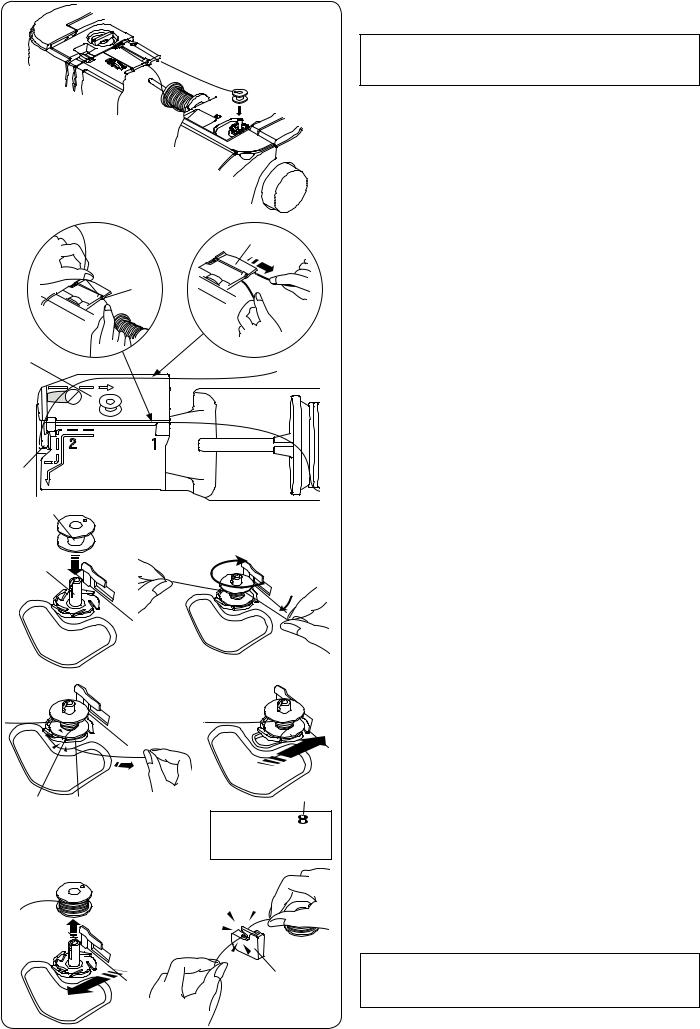
Winding the bobbin
NOTE:
Set the speed control slider at the fastest position (refer to page 8).
|
|
z Pull the thread from the spool. |
z |
x |
Hold the thread with both hands and pass the thread |
|
e |
into the guide slot q. |
|
|
q Guide slot |
|
q |
x Draw the thread to the left and forward around the |
|
|
thread guide w. |
|
|
Draw the thread to the rear and to the right around |
|
|
and under the guide plate e. |
e |
|
Firmly pull the thread to the right while holding it with |
|
both hands. |
|
|
|
|
|
|
w Thread guide |
|
|
e Guide plate |
w |
|
|
|
|
c |
r |
v |
|
c Put the bobbin on the bobbin winder spindle. |
|
|
|
|
rBobbin |
|
|
|
|
tBobbin winder spindle |
|
t |
|
|
v Pass the thread to the bobbin. |
|
|
|
|
|
|
|
|
|
Hold the thread with both hands and wind it around |
|
|
|
|
the bobbin clockwise several times. |
|
|
|
|
b Insert the thread into one of the slits u of the flange |
b |
|
n |
|
plate y and pull the thread to cut. |
|
|
yFlange plate |
||
|
|
|
|
|
|
|
|
|
uSlit |
|
|
|
|
n Push the bobbin to the right. The bobbin mark |
|
|
|
|
appears on the LCD screen. |
|
|
|
|
iBobbin mark |
|
u |
y |
i |
m Start the machine. |
|
|
|||
|
|
|
|
Stop the machine when the bobbin is fully wound and |
|
|
|
|
stops spinning. |
|
|
|
|
Return the bobbin winder spindle to its original |
m , |
|
|
position. |
|
|
|
|
||
|
|
|
|
, Remove the bobbin. Cut the thread with bobbin thread |
|
|
|
|
cutter B o. |
|
|
|
|
oBobbin thread cutter B |
|
|
o |
|
NOTE: |
|
|
|
For safety purposes, the machine will automatically |
|
|
|
|
|
stop 1.5 minutes after starting bobbin winding. |
15

z
q
 w
w
e





x
r
 t
t
c y
|
u |
Correct |
Wrong |
uu
v i


o
b
e
Inserting the bobbin
zTurn the power switch off.
Place a bobbin in the bobbin holder with the thread running off counterclockwise as shown on the hook cover plate.
qEnd of thread wBobbin holder eHook cover plate
xHold the bobbin with your fingertip so it does not rotate.
Guide the thread into the front notch of the bobbin holder.
Pull the thread to the left to pass it under the guide. rFront notch
tGuide
cDraw the thread to the left to pass it into the guide path marked “1”.
Make sure that the thread comes out from the side notch of the bobbin holder.
yGuide path 1 uSide notch
NOTE:
If the thread does not come out from the side notch, rethread from step z.
vContinue to draw the thread along the guide path marked “2” and pull the thread to the right through the slit. The thread will be cut to a proper length and held in place.
iGuide path 2 oSlit (Thread cutter)
bSet the left edge of the hook cover plate into opening. Push down the hook cover plate to fit in place.
NOTE:
Unless otherwise noted, you can start sewing without drawing up the bobbin thread.
Refer to page 19 for how to draw up the bobbin thread.
16
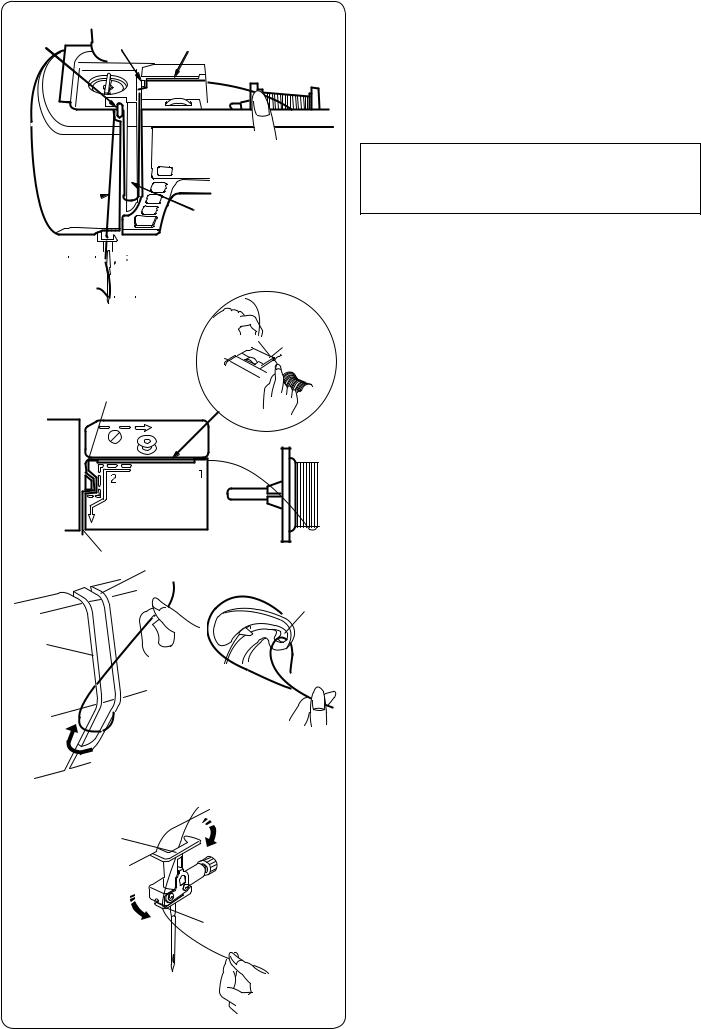
v x z
b c
c
n



 m
m
z
 q
q
w
x
e
e
c |
v |
y
t
 r
r
b n m
u
i
Threading the Machine
Raise the presser foot lifter to raise the presser foot. Turn the power switch on.
Press the needle up/down button to raise the take-up lever to the highest position.
Turn the power switch off.
Pass the thread in the order from z to m.
 CAUTION:
CAUTION:
Always make sure to turn the power switch OFF before threading the machine.
zHold the thread with both hands and pass the thread into the guide slot.
q Guide slot
xHold the thread with both hands and draw the thread around the corner of the guide.
Firmly pull the thread toward you along the right channel until the thread snaps.
w Corner of the guide e Right channel
cDraw the thread down along the right channel and around the bottom of the thread guide plate. Pull the thread up along the left channel.
e Right channel
r Thread guide plate t Left channel
vWhile holding the thread at the spool, firmly draw the thread up and to the back of the take-up lever. Draw the thread forward to slip it into the eye of the take-up lever.
y Eye of the take-up lever
bThen pull the thread down along the left channel and through the lower thread guide.
u Lower thread guide
nSlide the thread behind the needle bar thread guide on the left.
i Needle bar thread guide
mThread the needle with the needle threader (refer to the next page).
17
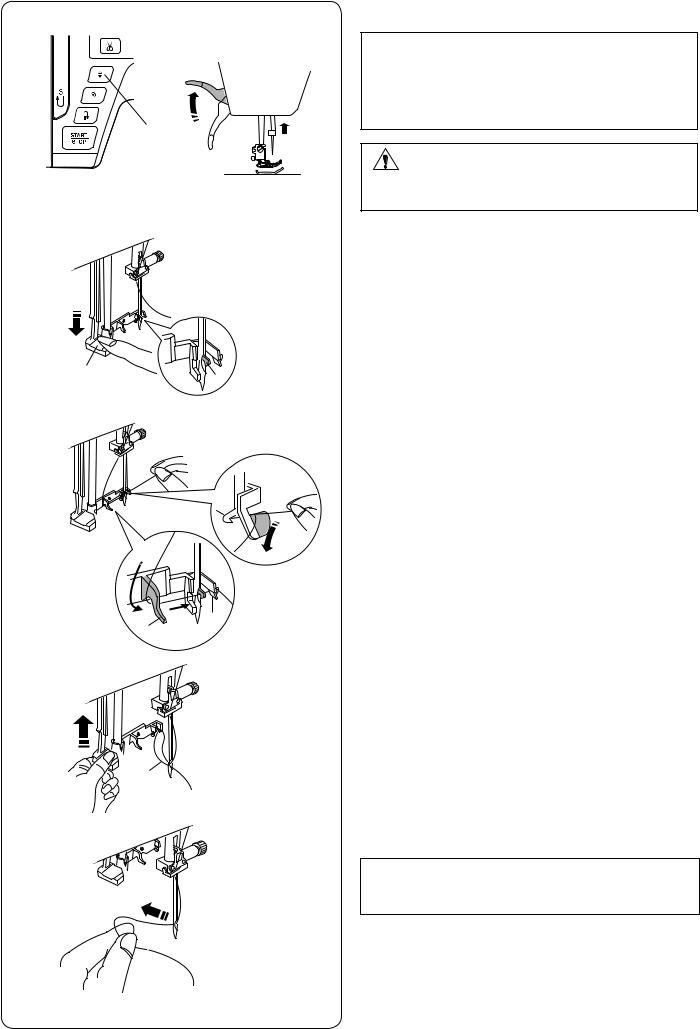
Built-in Needle Threader
z
|
NOTE: |
|
• The needle threader can be used with a #11 to #16 |
|
needle. |
|
Thread size 50 to 90 is recommended. |
|
• The needle threader cannot be used with the twin |
q |
needle. |
|
|
|
CAUTION: |
|
|
Always make sure to turn the power switch OFF |
|
|
before using the built-in needle threader. |
|
|
z Turn the power switch ON. |
|
|
Press the needle up/down button to raise the needle. |
|
|
Turn the power switch OFF. |
|
|
Pull down the needle threader knob as far as it will go. |
|
|
The threader hook comes out through the needle eye |
|
|
from behind. |
|
|
q Needle up/down button |
w |
|
w Threader knob |
e |
e Threader hook |
|
|
|
|
x |
|
x Draw the thread from left to right, under the left guide, |
|
|
threader hook and right guide. |
|
|
Draw the thread around the right guide toward you. |
|
|
r Left guide |
|
|
t Right guide |
|
t |
|
r |
c |
c Raise the threader slowly so a loop of the thread is |
|
pulled up through the needle eye. |
|
y Threader loop |
|
y |
v |
v Remove the thread end through the needle eye to the |
|
rear. |
|
NOTE: |
|
The needle threader cannot be used with the twin |
|
needle. |
18
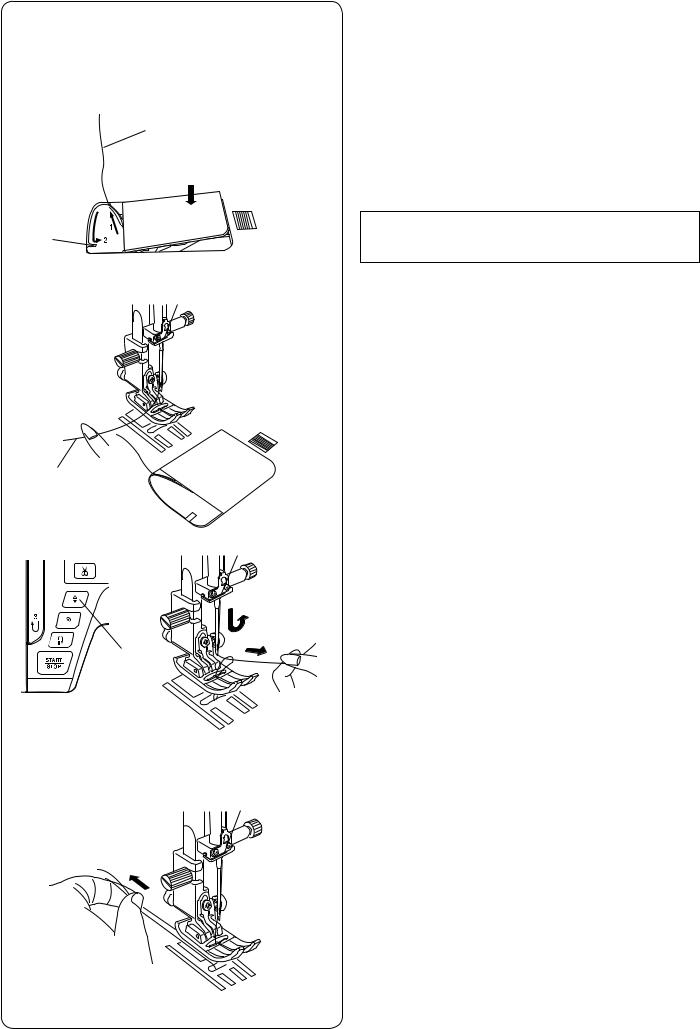
|
Drawing up the Bobbin Thread |
|
After using auto thread cutting or threading the bobbin |
|
holder, you can start sewing without drawing up the |
|
bobbin thread. |
|
However, you need to draw up the bobbin thread when |
z |
sewing gathering stitches etc. |
|
|
q |
z Remove the bobbin. Insert the bobbin into the bobbin |
|
holder again and rethread the bobbin holder according |
|
to the instructions on page 16, but leave a 10 cm (4˝) |
|
tail of bobbin thread as shown. |
|
qBobbin thread |
|
NOTE: |
w |
Do not cut the bobbin thread with the thread cutter. |
|
w Thread cutter |
x |
x Raise the presser foot. Hold the needle thread lightly |
|
with your left hand. |
|
eNeedle thread |
e
c
c Press the needle up/down button twice to lower and raise the needle and pick up the bobbin thread.
rNeedle up/down button
r
|
v Pull both threads 10 cm (4˝) under and behind the |
v |
presser foot. |
|
19
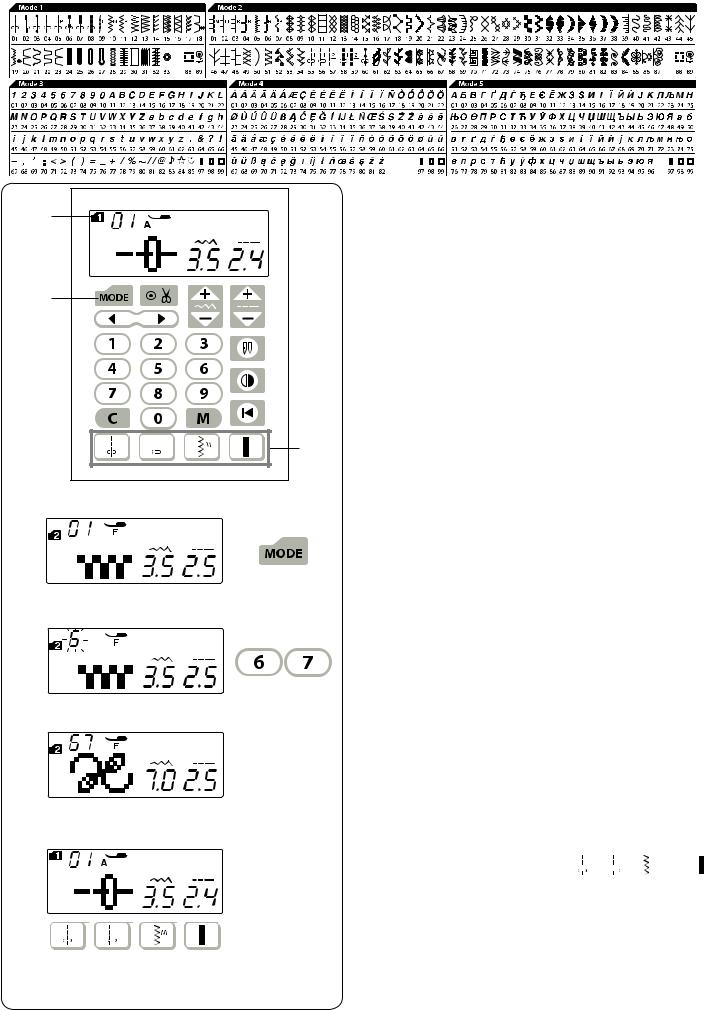
Selecting the Patterns
w |
q |
e |
z |
x |
c |
Mode 1–5
To select stitch patterns in modes 1–5, first press the mode key q to select your desired mode. Each time you press the mode key, the mode number w indicated on the left side of the screen will change, and the mode changes as follows,
Mode 1: Utility stitch pattern selection Mode 2: Decorative stitch pattern selection Mode 3: Number and letter selection
Mode 4: European accented letter selection Mode 5: Cyrillic letter selection
Example: To select stitch pattern 67 in mode 2
zTurn the power switch on.
When the power switch is turned on, the utility and decorative stitch pattern selection (mode 1) is set automatically.
Press the mode key once to select mode 2.
xPress the number keys on the touch panel. First press key 6 and then press key 7.
c Now pattern 67 in mode 2 is selected.
Direct pattern selection
You can select the stitch patterns 01 04
04 10
10  and 24 directly by pressing the corresponding direct pattern selection keys e.
and 24 directly by pressing the corresponding direct pattern selection keys e.
20
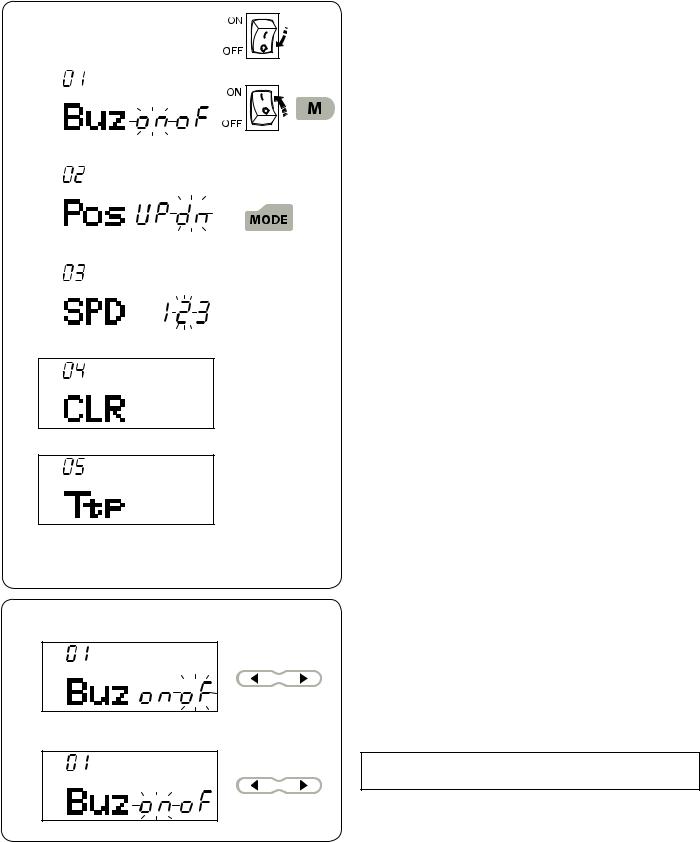
|
|
|
|
|
|
|
|
|
Customizing Machine Settings |
|
|
|
|
|
|
|
|
|
You can customize the machine settings to your |
|
|
e |
|
|
preference. |
||||
|
|
|
|
To enter the setting mode, turn the power off. |
|||||
|
|
|
|
|
|
|
|
|
|
r |
|
|
|
|
|
|
q |
Press and hold the memory key q and turn the power |
|
|
|
|
|
|
|
||||
|
|
|
|
|
|
|
switch on until the setting mode screen appears. |
||
|
|
|
|
|
|
|
|
|
|
|
|
|
|
|
|
|
|
|
Press the mode key w to select the desired setting. |
|
|
|
|
|
|
|
|
|
|
|
|
|
|
|
|
|
|
|
Each time you press the mode key, the mode number |
|
|
|
|
|
|
|
|
|
e changes, and you can set the machine functions as |
|
|
|
|
|
|
|
|
|
|
|
|
|
|
|
|
|
|
|
follows: |
t |
|
|
|
|
w |
|
|
r Buzzer sound setting |
|
|
|
|
|
|
|
||||
|
|
|
|
|
|
|
|
|
t Needle stop position setting |
|
|
|
|
|
|
|
|
|
y Start up speed setting |
|
|
|
|
|
|
|
|
|
u Resetting all to default |
|
|
|
|
|
|
|
|
|
i Key position calibration |
|
|
|
|
|
|
|
|
|
|
y |
|
|
|
|
|
|
|
|
To exit the setting mode, press the memory key. |
|
|
|
|
|
|
|
|
|
|
|
|
|
|
|
|
|
|
|
|
u
i
Buzzer sound setting
The buzzer sound can be turned on or off. The default buzzer sound setting is “ON”.
Enter the machine setting mode.
To turn off the buzzer sound, press the cursor key “  ” and the “oF” mark will blink.
” and the “oF” mark will blink.
To turn on the buzzer sound, press the cursor key “  ” and the “on” mark will blink.
” and the “on” mark will blink.
Press the memory key to apply the setting.
NOTE:
Caution buzzer sound cannot be turned off.
21
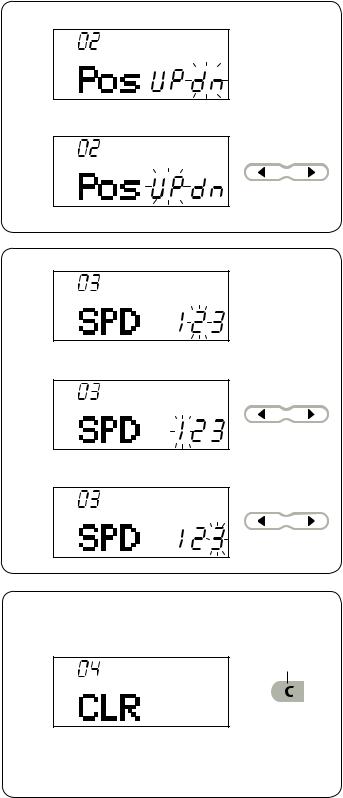
Needle stop position setting
The machine always stops with the needle in the down position except when sewing buttonholes, specialty stitches such as darning or eyelet, monograms, etc. However you can select the needle stop position up or down.
Enter the machine setting mode. Press the mode key to enter the needle stop position setting.
The default needle stop position setting is down position “dn”.
To change the needle stop position, press the cursor key “  ” and the “UP” mark will blink.
” and the “UP” mark will blink.
Press the memory key to apply the setting.
Start-up speed setting
The machine will start running slowly and the sewing speed will gradually increase to maximum when pressing the start/stop button.
You can select the desired start-up speed from 1 (slow),
2 (medium) or 3 (high).
Enter the machine setting mode. Press the mode key twice to enter the start-up speed setting.
The default start-up speed setting is “2” (medium). To change the start-up speed, press the cursor key “  ” or “
” or “  ”, and the selected speed number will blink.
”, and the selected speed number will blink.
Press the memory key to apply the setting.
Resetting all to default
The following customized settings can be reset to the default settings (factory settings).
• Buzzer sound
q• Needle stop position
• Start up speed setting
Enter the machine setting mode. Press the mode key 3 times to enter the Resetting all to default mode.
Press and hold the clear key q until the machine beeps to reset the machine to the factory default setting. Press the memory key to apply the setting.
22
